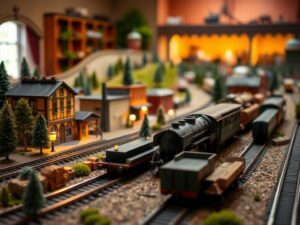How to Wire DCC for HO Scale Layouts
How to Wire DCC for HO Scale Layouts
Take Control of Your Tracks: How to Wire DCC for HO Scale Layouts
Hey fellow railfans! Welcome back to the blog. Today, we’re diving headfirst into a topic that’s going to transform your HO scale layout: Digital Command Control (DCC) wiring.
I know what you might be thinking – “DCC? Isn’t that for big fancy layouts?” Well, let me tell you, that’s an outdated notion! DCC has become increasingly accessible and affordable, allowing even hobbyists with modest space and budgets to enjoy the incredible realism and control it brings.
This blog post will guide you step-by-step through the essentials of DCC wiring for HO scale layouts, from understanding the basics to tackling advanced techniques. We’ll cover everything from track wiring to accessories and even throw in some valuable tips along the way.
Why Go Digital? Unleash Your Train Master Inner Enthusiast
Before we get into the nitty-gritty, let me tell you why DCC is so revolutionary. Imagine controlling each individual train on your layout with pinpoint accuracy. Want your engine to creep along a siding? No problem! Want it to speed up, slow down, or even whistle as it passes through a station? Easy peasy! DCC empowers you with that level of detail and dynamic control that traditional DC systems simply can’t match.
Here are just some of the incredible advantages DCC brings:
- Independent Train Control: Each locomotive on your layout becomes an independent entity, responding to its own programmed commands. You can run multiple trains simultaneously at different speeds and in various directions â think grand orchestrations of iron horses!
- Effortless Speed and Direction Control: Smooth acceleration and deceleration curves eliminate the frustrating jolts you get with traditional DC power packs. Change your engine’s direction instantly, without fiddling with switches or reversing mechanisms.
- Realism Enhanced: DCC opens up a world of possibilities for enhancing realism.
Use decoders to control lighting effects, activate sound features, and even implement different headlight settings based on the type of locomotive or time of day.
The Foundations: What You Need for Your DCC Journey
Getting started with DCC wiring for your HO scale layout is simpler than you might think. Let’s outline the essential components:
- DCC Controller: This is your command center, allowing you to send digital signals to each locomotive and accessory on your layout.
- Booster: As more trains add resistance (electrical draw) to your system, a booster enhances power delivery to keep those engines chugging smoothly. Think of it as a supercharged power supply for your trains.
- Power Supply: This provides the raw DC electricity that feeds into the entire DCC system.
- DCC Command Station: The heart of your operation! It acts as the brains, translating your controller commands into digital signals understood by locomotives and accessories.
- Wire & Connectors: You’ll need plenty of insulated wire to connect all your components together.
For our HO scale layouts, itâs wise to go with:
- 18 gauge wire for connecting feeders (sections of track) and smaller items.
- 14 gauge wire for your booster outputs.
Donât forget specialized connectors for easy installation!
Laying the Groundwork: Wiring Your HO Scale Track
Now let’s get to the meat and potatoes â the wiring!
- Establish a Clean Slate: Before you start laying any track, ensure you have a well-grounded surface to work on (using an anti-static mat helps too). This prevents static electricity from causing interference or damaging your components.
- Planning is Paramount: Before you touch that soldering iron, map out the configuration of your track layout meticulously.
Consider factors like the placement of turnout points (swithches), sections for running multiple trains simultaneously, and areas where you want to add special effects or staging yards.
-
Connect the Rail Ends: Use your wire gauge appropriately â smaller wire for the individual rails connecting each piece, and larger wire (18 or 14 gauge) for main feeder lines coming off your booster.
Ensure you secure your wires properly, as loose connections can lead to frustrating voltage drops or train stalling.
Pro Tip: Use short pieces of zip ties or other insulators to hold down wires between sections of track â this keeps them neat and prevents accidental shorts!
-
Adding Feeders: Run insulated feeder wires (larger gauge) from the booster outputs to strategic locations on your track. Think of these like “fuel lines” supplying power to different sections. Spacing feeders adequately (every 3-6 feet for moderate layouts) helps ensure a strong and even signal across your tracks.
-
Wiring Turnouts: Each turnout point (switch) requires additional wiring to control its position manually or digitally with DCC. There are numerous options available depending on your controller type, from basic manual throws to intricate DCC controlled switches with feedback loops.
Power Up Your Paradise: Bringing Your Layout to Life
With your track wired, it’s time to energize your railroad universe!
- Connect the Booster: Attach your booster to the power supply and carefully connect the positive and negative terminals. Remember those safety precautions!
-
Grounding for Excellence: Establish a reliable grounding connection â often a simple wire soldered directly to the rails in a secure spot â this protects your electronics from surges.
- Test Your Circuits: Use a multimeter or tester designed for DCC systems to ensure power flows properly throughout your track network. This can help identify any potential short circuits or wiring errors early on.
-
Bring It to Life!: Power up your command station, program your locomotives with their desired addresses and functions (speed limits, headlight options, sound features, etc.), and start rolling those engines! Experiment with different scenarios, watch your trains traverse your intricate network, and marvel at the transformation DCC has brought to your layout.
Level Up: Advanced Wiring Techniques
Once youâve grasped the fundamentals, it’s time to delve into more sophisticated techniques that can truly elevate your DCC wiring game.
-
Program Track Section Controllers (PTC): These allow for independent control of individual track sections â ideal for simulating yard switching, activating interlocking mechanisms, or even running elaborate run-through schemes.
-
Integrate Signal Systems: Enhance the realism and functionality of your layout with digitally controlled signal lights that react to the movement of your trains.
-
Harness Power Bus Lines: Utilizing bus wire throughout your track network simplifies feeder connections, minimizes resistance drops, and enhances signal clarity.
-
Dedicated Booster Circuits for Different Train Classes: Create dedicated booster outputs to cater to heavy freight engines and high-powered passenger trains â ensure everyone gets the power they need!
- Explore Advanced Control Options: Explore the realm of computer-based DCC systems with throttles integrated with touchscreen panels, customizable programming functions, and advanced control strategies for massive layouts.
Essential DCC Wiring Tips for HO Scale Layouts
Here are some golden nuggets to make your DCC wiring journey a smooth and successful one:
-
Start Small, Scale Up: Begin with a smaller section of track, perfect for learning the basics. Once comfortable, expand gradually.
-
Color-Coding Is Your Friend: Label all your wires clearly â positive (+) and negative (-) terminals â using colored electrical tape or heat shrink tubing.
-
Avoid Sharp Bends in Wires: This minimizes resistance and prevents signal disruptions. Utilize flexible wire as needed.
-
Invest in Quality Connectors: Good-quality solderless connectors ensure secure connections that are easy to assemble and disassemble, especially if you’re ever expanding or modifying your layout.
-
Keep Your Wiring Neat & Tidy: Organize cables and use cable ties to bundle wires securely, making troubleshooting easier down the road.
- Consult Diagrams: Always refer back to wiring diagrams provided with your DCC system components.
Conductors to Success: Insights for Aspiring HO Scale Train Operators
DCC opens up a world of exciting possibilities for any model railroad enthusiast, whether you’re a beginner or a seasoned veteran. As you embark on this DCC wiring adventure, remember that practice makes perfect. Don’t be afraid to experiment, learn from mistakes (we all make them!), and continually refine your setup to create a truly exceptional and immersive HO scale layout that captures the magic of train travel.
Stay tuned for future blog posts where weâll explore even more fascinating aspects of DCC operation, like programming decoder functions, customizing your command station experience, and implementing realistic lighting effects. Until then, happy railroading!




